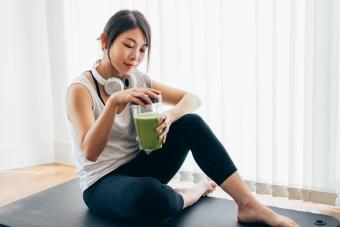
About fifty years ago, doctors started asking women to check their own breasts for changes, in the hopes that they would catch any tumors while they were still small. As a result of this effort, a recommendation for monthly self-breast exams has been promoted in health classes, in doctor's offices, and online. But many women try the exam only to end up confused. Am I doing it right? The whole thing is lumpy! Did I miss a spot?
While you're still getting used to performing self-breast exams (SBEs), it's easy to feel intimidated. The main point of the exercise -- especially the regularity of your exams -- is to get to know your breasts over time. If you check yourself frequently, you'll know pretty quickly if anything has changed.
Why Should I Do a Self-Breast Exam?
So why do your breasts need to be examined anyway? And why do these tests need to be done so frequently?
According to the American College of Obstetricians and Gynecologists (ACOG), "Breast cancer is the most commonly diagnosed cancer in women in the United States and the second leading cause of cancer death in American women." ACOG tells us that early detection of breast cancer is absolutely key to its successful treatment.
While your healthcare provider can perform an exam to find changes in your breast tissue, no one knows your body like you do. And no one wants to go to the doctor once a month for a breast exam.
While you may feel scared to find anything, just remember: if something's growing in there, you want to find it. If you ignore a bump, it will keep growing. But if you find it and tell your doctor, you can do something about it. Your monthly self-breast exam could be key to early detection and survival.
When to Do a Self-Breast Exam
Medline Plus recommends doing your self-breast exam about 3-5 days after your period starts. By this point, your breasts should be less tender. Your breasts go through natural changes throughout your cycle, so if you check them at different times of the month, they will feel different, and it will be harder to notice any variations.
How to Do a Self-Breast Exam
Technique is important for making sure that your SBE is effective. According to the National Breast Cancer Foundation (NBCF), self-breast exam guidelines show that how you do your SBEs is just as important as when or why.

Choose Your Position
The NBCF says that you can do your self-exam while standing, sitting, or lying down. Visual inspection is best-done standing or sitting, but when it's time to feel your breasts for changes, you can choose any position.
Look for Changes
The first step, according to The National Library of Medicine (NLM), is to look at yourself in the mirror standing or sitting.
- Raise your arms above your head and look for any differences in your breast from the month before.
- Put your hands on your hips and push down to flex your chest muscles. Look again for any changes in your breasts, but pay special attention to the lower ridge of each breast.
While you do these steps, watch for:
- Dimples (like something is pulling from the inside of your breast)
- Inverted nipples (nipples falling into your breast instead of poking out)
- New asymmetry (breasts look different from each other)
- Nipple discharge
- Puckering (opposite of dimpling - an area sticking out)
- Size differences
Remember, the whole point is to look for differences over time. You may have a dimple that's been there for years. That dimple is less concerning than one that has just appeared. Focus on anything that looks new or different.
Feel for Changes
You can do your exam lying down, sitting, or standing. If standing, try to do it in the shower and get your hands soapy so they will glide over the skin, making it easier to feel any changes. Some people prefer lying down to check their breasts because they flatten out, which can make it easier to feel something that shouldn't be there.
During an SBE, feel for:
-
Bumps
-
Lumps
-
Thickening skin or breast tissue
Once you've done SBEs for a couple of months in a row, you'll start to get a sense of how they should feel.
Try Different Techniques
You have several technique options when feeling for changes in your breasts. The NLM recommends using your right hand to check your left breast and vice versa. You can use any of these patterns:
- Compass
- Spiral/swirl
- Straight up and down
Be sure to gently pinch your areola on each side to check for nipple discharge. Use the pads of your middle three fingers and not the tips. Feel each breast pushing your fingers with soft, medium, and hard pressure. Take your time - if you rush through the exam, you may miss something. Whether you choose the compass pattern, spiral, or straight up and down, try to use the same technique each time you do your SBE.
What Happens After Your Self-Breast Exam?
Give yourself a few months to get used to examining your breasts and getting to know how they feel. At first, your breast will feel like it's made of lumps, especially when you push hard. Your breast contains fat, yes, but it also carries a network of ducts, lobes, and lobules (that hold breast milk). Even when not filled with milk, you'll still feel these structures. As you do SBEs more and more, you'll get to know the geography of your breast very well.
Once you become familiar with your breasts and each month your breasts feel the same, then there is no need for concern. Just continue to do your monthly checks. But if you notice changes, you may want to check in with your healthcare provider. Further testing may be warranted.
When to Call Your Doctor
Once you have gotten the hang of it, here's what the NBCF tells us to look and feel for:
- Changes from your last exam. These may include new dimpling or pulling or a new inverted nipple
- Hard lump anywhere on your breast or near your underarm
- Nipple discharge other than breastmilk
- Pain with warmth and redness
- Sores or rashes
A good rule of thumb is to call or see a doctor if you are at all unsure about what you are feeling. If you don't have a healthcare provider, you can use Planned Parenthood to find a nearby location where you can get a free checkup.
Further Testing
If your doctor does a clinical breast exam and confirms a suspicious area, they will want to get a look inside. According to the NBSF, they may order a mammogram, ultrasound, or MRI to get a closer look. If they do see a growth, you may need a biopsy.

In a biopsy, your doctor numbs your breast, so you don't feel a thing. Then they place a needle through your breast to the growth and take a tiny piece of it. They send it off to the lab to look at it under a microscope and see what it is. Your doctor will call you with all your results, either from imaging or a biopsy.
Have Self-Breast Exam Recommendations Changed?
Like many health recommendations, the guidelines surrounding breast self-exams have been challenged and questioned. Research results have been mixed. Many doctors still advise doing the monthly checks for cancer prevention and for overall health awareness.
Research
Several large-scale studies done in China and India in the early 2000s seemed to debunk the idea that self-breast exams can save lives. Some follow-up studies found the same results. The National Cancer Institute actually reports evidence that SBEs can cause harm by way of wasting resources on testing benign growths.
However, a more recent study was conducted in 2015. It included 15,000 participants and found different results, suggesting that SBEs may still hold an important place in breast cancer prevention.
Potential Risks
Some of the studies above came to the conclusion that not only do SBEs fail to prevent advanced breast cancer, but they also propose that SBEs can actually cause harm. Here's how:
- Anxiety: Some doctors worry that SBE will cause unnecessary anxiety for people when they think they feel something and have to wait days or maybe weeks to have it confirmed by a doctor.
- Delay of care: Other clinicians have a concern that women will delay visits to the doctor or annual mammograms because they don't feel anything unusual in their breasts.
- Overuse of testing: Others claim SBE prevalence has led to over-testing for benign or non-existent growths.
Physician Recommendations
Concerns regarding potential risks are valid, but some health professionals still feel that SBE can be a helpful tool, especially for women with a lower income and fewer resources who may not be able to visit a doctor regularly. Even if a doctor doesn't recommend SBEs, many still encourage women to be familiar with their breasts.
Dr. Nancy Elliott, Director & Founder of Montclair Breast Center, says, "Most women are not familiar with their breasts! After 30 years of examining breasts in women of all ages, we still find breast masses that we're amazed women didn't notice themselves. There is a problematic relationship with breast self-exams; women are deterred from touching their own breasts due to fear and uncertainty, so we do not advocate self-breast exams.
Instead, we counsel our women on breast massage for health and wellness. Breast massage is a daily practice, like brushing your teeth and combing your hair. Daily breast massage creates a familiarity with what is normal and natural and can even help prevent breast cancer. Self-massage is an ideal way to be familiar with your breasts and recognize any changes as they occur."
Dr. Lauren Demosthenes, senior medical director at Babyscripts, says, "I do not recommend self-breast exams, but I do recommend breast awareness because self-exam has not been shown to improve outcomes. However, we do know that women who are aware of changes and seek professional advice often catch a problem earlier."
The Bottom Line on Self-Breast Exams
Considering the pros and cons of monthly exams might give leave you somewhat confused. But here's the deal: UC Davis reports that false positives are extremely common. So if you feel something strange during your SBE, you should definitely see your doctor, but also know that the chances are high that it's nothing.
The American Cancer Society reports that 1 in 8 women will develop breast cancer at some point in their lives. However, they also report that breast cancer deaths have steadily declined since 1989, largely in part to early diagnosis and treatment. You have the power to catch any breast problems early - so get to know your breasts!







